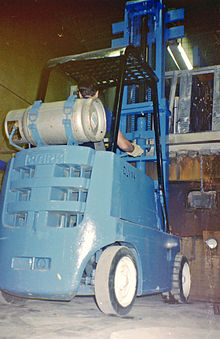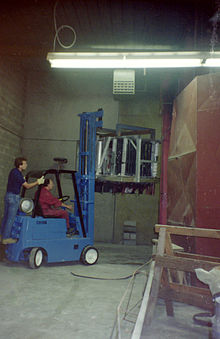- Workplace safety
-
Workplace safety & health is a category of management responsibility in places of employment.
To ensure the safety and health of workers, managers establish a focus on safety that can include elements such as:
- management leadership and commitment
- employee engagement
- accountability
- safety programs, policies, and plans
- safety processes, procedures, and practices
- safety goals and objectives
- safety inspections for workplace hazards
- safety program audits
- safety tracking & metrics
- hazard identification and control
- safety committees to promote employee involvement
- safety education and training
- safety communications to maintain a high level of awareness on safety
Contents
Workplace fatalities statistics
European Union
Country Fatalities Fatalities per
100,000 employeesAustria 145 1.71 Belgium 41 2.4 Denmark 27 1.8 Finland 29 1.9 France 318 2.9 Germany 465 2.3 Greece 48 3.0 Ireland 52 3.2 Italy 427 2.8 Luxembourg 6 3.2 Netherlands 60 2.0 Portugal 285 7.6 Spain 365 3.7 Sweden 28 1.2 United Kingdom 182 1.1 European Union 2,478 2.5 Data from 2003 [1]
In most countries males comprise the vast majority of workplace fatalities. In the EU as a whole, 94% of death were of males.[1] In the UK the disparity was even greater with males comprising 97.4% of workplace deaths.[2][3]
US Statistics
The Bureau of Labor Statistics of the United States Department of Labor compiles information about workplace fatalities in the United States. Since 1992, the year with the most workplace fatalities was 1994 with 6,632 fatalities, and the lowest in 2002 with 5,534.

The Bureau also compiles information about the most dangerous jobs. The most recent information comes from the year 2006, during which 5,840 people died on the job.Job Fatalities Fatalities per
100,000 employeesFishermen 53 147.2 Pilots 104 90.4 Timber cutter 66 84.6 Structural metal workers 36 61.0 Waste collectors 37 40.7 Farmers and ranchers 292 37.2 Power-line workers 38 34.9 Miners 156 34.5 Roofers 81 33.5 Truck drivers 957 27.5 All occupations 5,840 4.0 See also
- Certified safety professional
- CCOHS
- Effective Safety Training
- Hearing conservation program
- Industrial Union Department v. American Petroleum Institute
- Material safety data sheet
- National Institute for Occupational Safety and Health (NIOSH)
- Occupational disease
- Occupational fatality
- Occupational health psychology
- Occupational safety and health
- OSHA
- Participatory Ergonomics
- Process Safety Management
- Safe-In-Sound Award Excellence in Hearing Loss Prevention Award
- Safety
- Safety engineering
- Safety Services Company
References
- ^ http://www.emhf.org/resource_images/Vienna_Declaration_Bgrd_Doc.pdf
- ^ http://www.hse.gov.uk/statistics/tables/agegen1.htm
- ^ http://www.hse.gov.uk/statistics/tables/agegen2.htm
External links
- OSH Answers
- Canadian Centre for Occupational Health and Safety (CCOHS)
- History of Workplace Safety in the United States by Mark Aldrich of Smith College
- Occupational Safety & Health Administration
- National Institute for Occupational Safety and Health
- National Safety Council
- Free OSHA Publications
- New Zealand Department of Labor
- International Labour Organization
- Institution of Occupational Safety and Health UK-based professional organization
- Forbes: Dangerous jobs
- CNN: Dangerous jobs
- National Association of Safety Professionals
- American Society of Safety Engineers
- Occupational Safety Training and Certification Alliance
- European Agency for Safety and Health at Work (EU)
- Healthy Workplace Initiative (new member states)
- Workplace Fatalities & the Aftermath United Support & Memorial for Workplace Fatalities
- Safety Manual
Aspects of workplaces See also: template Aspects of corporations · template Aspects of occupations · template Aspects of organizations · template Employment · Corporation · Employment · Factory · Office · Organization · WhistleblowerAbsenteeism · Aggression · Bullying · Conflict · Control freak · Counterproductive behavior · Coworker backstabbing · Cyber-aggression · Democracy · Deviance · Discrimination · Diversity · Emotion · Employee silence · Employee surveys · Empowerment · Evaluation · Feminisation · Friendship · Gender inequality · Gossip · Happiness · Harassment · Health surveillance · Humor · Incivility · Intervention · Jargon · Listening · Micromanagement · Mobbing · Morale · Office politics · Performance appraisal · Phobia · Privacy · Probation · Profanity · Queen bee syndrome · Revenge · Sabotage · Safety · Spirituality · Staff turnover · Strategy · Stress · Surveillance · Toxic workplace · Training · Violence · WellnessCategories:
Wikimedia Foundation. 2010.


